HP 3500 and 3500 yl Switch Series
30 in stock
AED1,899.00
30 in stock
HP Pro 3500 MT, Intel I3 3240 (3.3 Ghz), 2GB DDR3 1333MHZ,500GB ( 7200 rpm ) SATA, DVD+/- RW Drive, Keyboard & Mouse,Dos, 1 Year Warranty
HP 3500 and 3500 yl Switch Series
Product overview
The HP 3500 Switch Series consists of advanced intelligent-edge switches, available in 24-port and 48-port fixed-port models. The foundation for these switches is a purpose-built, programmable HP ProVision ASIC that allows the most demanding networking features, such as quality of service (QoS) and security, to be implemented in a scalable yet granular fashion. With a variety of Gigabit Ethernet and 10/100 interfaces; integrated PoE+, PoE, and non-PoE options; and versatile 10GbE connectivity (CX4, X2, and SFP+) on Gigabit Ethernet switches, the 3500 Switch Series offers excellent investment protection, flexibility, and scalability, as well as ease of deployment, operation, and maintenance.
- Advanced access layer and small distribution
- Enterprise-class performance and security
- Intelligent edge feature set with L2 to L4 support
- Scalable 10/100/1000 PoE+ and 10/100 PoE
- Unified core-to-edge HP ProVision software
Quality of Service (QoS)
- Advanced classifier-based QoS — classifies traffic using multiple match criteria based on Layer 2, 3, and 4 information; applies QoS policies such as setting priority level and rate limit to selected traffic on a per-port or per-VLAN basis
- Layer 4 prioritization — enables prioritization based on TCP/UDP port numbers
- Traffic prioritization — allows real-time traffic classification into eight priority levels mapped to eight queues
- Bandwidth shaping —Class of Service (CoS) — sets the IEEE 802.1p priority tag based on IP address, IP Type of Service (ToS), Layer 3 protocol, TCP/UDP port number, source port, and DiffServ
- Port-based rate limiting — provides per-port ingress-/egress-enforced increased bandwidth
- Classifier-based rate limiting — uses an access control list (ACL) to enforce increased bandwidth for ingress traffic on each port
- Reduced bandwidth — provides per-port, per-queue egress-based reduced bandwidth
Management
- Remote intelligent mirroring — mirrors selected ingress/egress traffic based on ACL, port, MAC address, or VLAN to a local or remote HP 8200 zl, 6600, 6200 yl, 5400 zl, or 3500 Switch anywhere on the network
- RMON, XRMON, and sFlow v5 — provide advanced monitoring and reporting capabilities for statistics, history, alarms, and events
- IEEE 802.1AB Link Layer Discovery Protocol (LLDP) — advertises and receives management information from adjacent devices on a network, facilitating easy mapping by network management applications
- Uni-Directional Link Detection (UDLD) — monitors a cable between two switches and shuts down the ports on both ends if the cable is broken, turning the bidirectional link into a unidirectional one; this prevents network problems such as loops
- Management simplicity — common software features and CLI implementation across all ProVision-based switches (including the zl and yl switches)
- Command authorization — leverages RADIUS to link a custom list of CLI commands to an individual network administrator’s login; an audit trail documents activity
- Friendly port names — allows assignment of descriptive names to ports
- Dual flash images — provides independent primary and secondary operating system files for backup while upgrading
- Multiple configuration files — stores easily to the flash image
- Comware CLI —
- Comware-compatible CLI — bridges the experience of HP Comware CLI users who are using the HP ProVision software CLI
- Display and fundamental Comware CLI commands — are embedded in the switch CLI as native commands; display output is formatted as on Comware-based switches, and fundamental commands provide a Comware-familiar initial switch setup
- Configuration Comware CLI commands — when Comware commands are entered, CLI help is elicited to formulate the correct ProVision software CLI command
Connectivity
- IEEE 802.3af Power over Ethernet (PoE) — provides up to 15.4 W per port to IEEE 802.3af-compliant PoE-powered devices such as IP phones, wireless access points, and security cameras
- IEEE 802.3at Power over Ethernet Plus (PoE+) — provides up to 30 W per port to IEEE 802.3 for devices that use PoE/PoE+, such as video IP phones, IEEE 802.11n wireless access points, and advanced pan/zoom/tilt security cameras
- Prestandard PoE support — detects and provides power to prestandard PoE devices; see list of supported devices in the product FAQs at www.hp.com/networking
- Jumbo frames — on Gigabit Ethernet and 10-Gigabit Ethernet ports, jumbo frames allow high-performance remote backup and disaster-recovery services
- Auto-MDIX — provides automatic adjustments for straight-through or crossover cables on all 10/100 and 10/100/1000 ports
- IPv6 —
- IPv6 host — enables switches to be managed in an IPv6 network
- Dual stack (IPv4 and IPv6) — transitions from IPv4 to IPv6, supporting connectivity for both protocols
- MLD snooping — forwards IPv6 multicast traffic to the appropriate interface
- IPv6 ACL/QoS — supports ACL and QoS for IPv6 network traffic
- IPv6 routing — supports static and OSPFv3 routing protocols
- 6in4 tunneling — supports encapsulation of IPv6 traffic in IPv4 packets
Performance
- High-speed/capacity architecture — up to 153.6 Gbps crossbar switching fabric provides intra- and inter-module switching with up to 111.5 million pps throughput on the purpose-built ProVision ASICs
- Selectable queue configurations — allows for increased performance by selecting the number of queues and associated memory buffering that best meet the requirements of the network applications
Resiliency and high availability
- NEW Virtual Router Redundancy Protocol (requires Premium License) — allows groups of two routers to dynamically back each other up to create highly available routed environments
- IEEE 802.1s multiple Spanning Tree Protocols — provides high link availability in multiple VLAN environments by allowing multiple spanning trees; encompasses IEEE 802.1D Spanning Tree Protocol and IEEE 802.1w Rapid Spanning Tree Protocol
- IEEE 802.3ad Link Aggregation Control Protocol (LACP) and HP port trunking — support up to 144 trunks, each with up to eight links (ports) per trunk
- Distributed trunking — enables loop-free and redundant network topology without using Spanning Tree Protocol; allows a server or switch to connect to two switches using one logical trunk for redundancy and load sharing
- Uplink Failure Detection — provides active-standby network path redundancy for servers that are configured for active-standby NIC teaming
- NEW SmartLink — provides easy-to-configure link redundancy of active and standby links
Layer 2 switching
- IEEE 802.1ad Q-in-Q (requires Premium License) — increases the scalability of an Ethernet network by providing a hierarchical structure; connects multiple LANs on a high-speed campus or metro network
- HP switch meshing — dynamically load balances across multiple active redundant links to increase available aggregate bandwidth
- VLAN support and tagging — supports the IEEE 802.1Q standard and 2,048 VLANs simultaneously
- IEEE 802.1v protocol VLANs — isolate select non-IPv4 protocols automatically into their own VLANs
- GARP VLAN Registration Protocol — allows automatic learning and dynamic assignment of VLANs
- Rapid Per-VLAN Spanning Tree (RPVST+) — allows each VLAN to build a separate spanning tree to improve link bandwidth usage; is compatible with PVST+
Layer 3 services
- User Datagram Protocol (UDP) helper function — allows UDP broadcasts to be directed across router interfaces to specific IP unicast or subnet broadcast addresses and prevents server spoofing for UDP services such as DHCP
- Loopback interface address — defines an address in Routing Information Protocol (RIP) and Open Standard Path First (OSPF), improving diagnostic capability
- Route maps — provide more control during route redistribution; allow filtering and altering of route metrics
Layer 3 routing
- Static IP routing — provides manually configured routing for both IPv4 and IPv6 networks
- Routing Information Protocol (RIP) — provides RIPv1 and RIPv2 routing
- OSPF (requires Premium License) — provides OSPFv2 for IPv4 routing and OSPFv3 for IPv6 routing
- Border Gateway Routing Protocol (requires Premium License) — provides IPv4 Border Gateway Routing Protocol that is scalable, robust, and flexible
Security
- Access control lists (ACLs) — provide filtering based on the IP field, source/destination IP address/subnet, and source/destination TCP/UDP port number on a per-VLAN or per-port basis
- Multiple user authentication methods —Virus throttling — detects traffic patterns typical of worm-type viruses and either throttles or entirely prevents the virus from spreading across the routed VLANs or bridged interfaces without requiring external appliances
- IEEE 802.1X users per port — provides authentication of multiple IEEE 802.1X users per port
- Web-based authentication — authenticates from Web browser for clients that do not support IEEE 802.1X supplicant
- MAC-based authentication — client is authenticated with the RADIUS server based on client’s MAC authentication
- Concurrent IEEE 802.1X, Web, and MAC authentication schemes per port — switch port accepts up to 32 sessions of IEEE 802.1X, Web, and MAC authentications
- DHCP protection — blocks DHCP packets from unauthorized DHCP servers, preventing denial-of-service attacks
- Secure management access — delivers secure encryption of all access methods (CLI, GUI, or MIB) through SSHv2, SSL, and/or SNMPv3
- USB Secure Autorun (requires HP PCM+) — deploys, diagnoses, and updates a switch using a USB flash drive; works with a secure credential to prevent tampering
- Switch CPU protection — provides automatic protection against malicious network traffic trying to shut down the switch
- ICMP throttling — defeats ICMP denial-of-service attacks by enabling any switch port to automatically throttle ICMP traffic
- Identity-driven ACL — enables implementation of a highly granular and flexible access security policy and VLAN assignment specific to each authenticated network user
- STP BPDU port protection — blocks Bridge Protocol Data Units (BPDUs) on ports that do not require BPDUs, preventing forged BPDU attacks
- Dynamic IP lockdown — works with DHCP protection to block traffic from unauthorized hosts, preventing IP source address spoofing
- Dynamic ARP protection — blocks ARP broadcasts from unauthorized hosts, preventing eavesdropping or theft of network data
- STP root guard — protects the root bridge from malicious attacks or configuration mistakes
- Detection of malicious attacks — monitors 10 types of network traffic and sends a warning when an anomaly that potentially can be caused by malicious attacks is detected
- Port security — allows access only to specified MAC addresses, which can be learned or specified by the administrator
- MAC address lockout — prevents particular configured MAC addresses from connecting to the network
- Source-port filtering — allows only specified ports to communicate with each other
- RADIUS/TACACS+ — eases switch management security administration by using a password authentication server
- Secure shell — encrypts all transmitted data for secure remote CLI access over IP networks
- Secure Sockets Layer (SSL) — encrypts all HTTP traffic, allowing secure access to the browser-based management GUI in the switch
- Secure FTP — allows secure file transfer to and from the switch; protects against unwanted file downloads or unauthorized copying of a switch configuration file
- Management Interface Wizard — helps secure management interfaces such as SNMP, telnet, SSH, SSL, Web, and USB at the desired level
- Switch management logon security — helps secure switch CLI logon by optionally requiring either RADIUS or TACACS+ authentication
- Security banner — displays a customized security policy when users log in to the switch
Convergence
- IP multicast routing (requires Premium License) — includes PIM Sparse and Dense modes to route IP multicast traffic
- IP multicast snooping (data-driven IGMP) — prevents flooding of IP multicast traffic
- LLDP-MED (Media Endpoint Discovery) — defines a standard extension of LLDP that stores values for parameters such as QoS and VLAN to automatically configure network devices such as IP phones
- PoE allocations — supports multiple methods (automatic, IEEE 802.3af class, LLDP-MED, or user-specified) to allocate PoE power for more efficient energy savings
- Auto VLAN configuration for voice —NEW Local MAC Authentication — assigns attributes such as VLAN and QoS using locally configured profile that can be a list of MAC prefixes
- RADIUS VLAN — uses a standard RADIUS attribute and LLDP-MED to automatically configure a VLAN for IP phones
- CDPv2 — uses CDPv2 to configure legacy IP phones
Warranty and support
- Lifetime Warranty 2.0 — advance hardware replacement for as long as you own the product with next-business-day delivery (available in most countries)†
Based on 0 reviews
Only logged in customers who have purchased this product may leave a review.
Related products
-
Network Switches & Routers, Switches
Hp 1910-8-Poe+ Switch – 8 Ports – Manageable – 8 X Poe+ – 2 X Expansion Slots – 10/100Base-Tx, 10/100/1000Base-T – Rack-Mountable
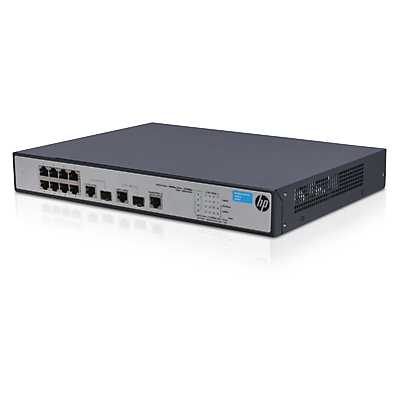 Network Switches & Routers, Switches
Network Switches & Routers, SwitchesHp 1910-8-Poe+ Switch – 8 Ports – Manageable – 8 X Poe+ – 2 X Expansion Slots – 10/100Base-Tx, 10/100/1000Base-T – Rack-Mountable
0 out of 5(0)SKU: JG537AAED1,299.00
 04 3550600
04 3550600 052 7036860
052 7036860 info@techsouq.com
info@techsouq.com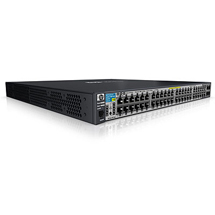
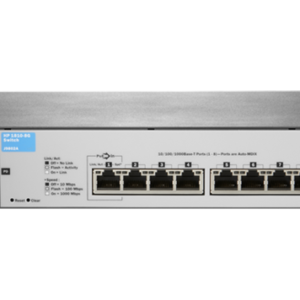
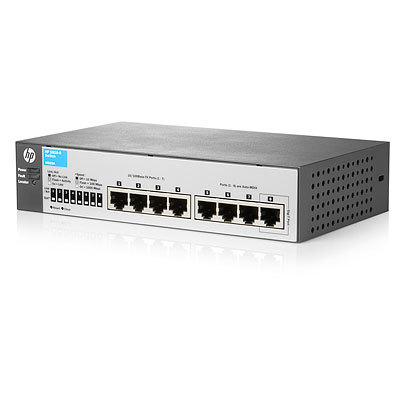
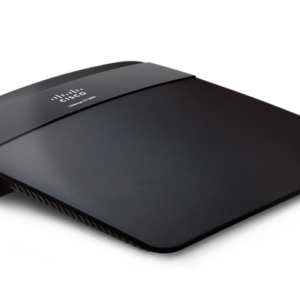

There are no reviews yet.